

The Best Resources For Helping Teachers Use Bloom’s Taxonomy In The Classroom. Bloom’s & SOLO ‘are not Just Colorful Posters we Hang on the Wall’ is my two-part series at Education Week Teacher.

Bloom’s Taxonomy is talked about a lot in educational circles. However, if you believe a recent survey of visits to 23,000 U.S. classrooms, the higher-order thinking skills it’s ideally designed to promote doesn’t get much use. And I can understand why. It’s easy to get caught-up in the day-to-day work involved in teaching a class or multiple classes, and it’s easy to fall into the trap of doing the “usual stuff” and not “think out of the box.” I thought it might be useful to share in a “The Best…” list the resources that help me try to use Bloom’s Taxonomy in my classroom. Bloom's Taxonomy of Learning Domains. Note: This site is moving to KnowledgeJump.com.
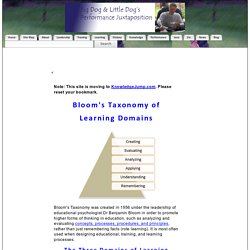
Please reset your bookmark. Bloom's Taxonomy was created in 1956 under the leadership of educational psychologist Dr Benjamin Bloom in order to promote higher forms of thinking in education, such as analyzing and evaluating concepts, processes, procedures, and principles, rather than just remembering facts (rote learning). It is most often used when designing educational, training, and learning processes. Bloom's Taxonomy Resources. NCPI Assessment Toolkit: Inventory of Instruments. The following inventory of assessment instruments was compiled to serve as a resource for state policy-makers who are responsible for implementing assessment protocol.
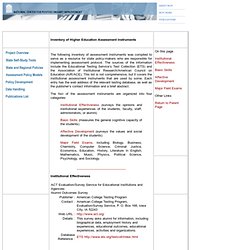
The sources of the information include the Educational Testing Service’s Test Collection (ETS) and the Association of Institutional Research/American Council on Education (AIR/ACE). This list is not comprehensive, but it covers the institutional assessment instruments that are used by some. Each entry has the web address of the relevant testing database, as well as the publisher’s contact information and a brief abstract. National Institute for Learning Outcomes Assessment. Assessment happens at multiple levels within institutions of higher education.

This page provides resources and examples of assessment activities within a variety of programs. Architecture Art Arts & Humanities Biology Business Chemistry Communications Dentistry Economics Education Engineering English Food Science Foreign Language History Journalism Law Library Mathematics Museum Studies Nursing Pharmacy Philosophy Physics Political Science Psychology Religious Studies Sociology Student Affairs Theatre Women's Studies General Resources for all disciplines AIR: Association for Institutional Research Assessment by the disciplines Carey, S.J. (Ed.). A compiled list of articles, publications, institutional examples/links, and higher education organizations that is organized by disciplines.
Architecture. NCPI Assessment Toolkit: Inventory of Instruments. 3 Rubric Makers That Will Save You Time And Stress. Rubrics can be an incredibly useful tool for your classroom.
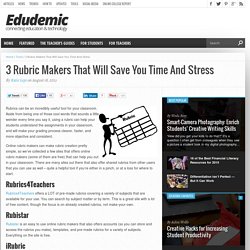
Aside from being one of those cool words that sounds a little weirder every time you say it, using a rubric can help your students understand the assignments in your classroom, and will make your grading process clearer, faster, and more objective and consistent. Online rubric makers can make rubric creation pretty simple, so we’ve collected a few sites that offers online rubric makers (some of them are free) that can help you out in your classroom. There are many sites out there that also offer shared rubrics from other users that you can use as well – quite a helpful tool if you’re either in a pinch, or at a loss for where to start.
Rubrics4Teachers Rubrics4Teachers offers a LOT of pre-made rubrics covering a variety of subjects that are available for your use. Rubistar iRubric iRubric is a pretty great tool. Affective Domain Taxonomy. LearningTaxonomy_Affective. LearningTaxonomy_Psychomotor. Psychomotor Domain taxonomy. Psychomotor objectives focus on physical and kinesthetic skills (including keyboarding, using technical instruments and other skills).
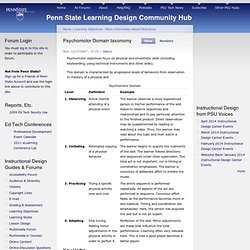
This domain is characterized by progressive levels of behaviors from observation to mastery of a physical skill. Key Verbs Below are key verbs associated with each cognitive domain. Using verbs such as these is beneficial to writing effective learning objectives, bendgrasphandleoperatereachrelaxshortenstretchwritedifferentiate (by touch)perform (skillfully) Additional Links. Bloom's Taxonomy of Learning Domains. Assessment. SLOA: The chair of each department (or equivalent as identified by the Dean or Director) shall prepare a report/summary every two years, summarizing the Educational Effectiveness program for each certificate and degree program offered by that department.
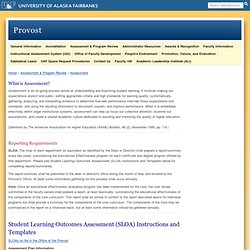
Please see Student Learning Outcomes Assessment (SLOA) Instructions and Templates below for completing reports/summaries. The report/summary shall be presented to the dean or director's office during the month of May and emailed to the Provost's Office. At least some information gathering for this process shall occur annually. Core: Once an educational effectiveness evaluation program has been implemented for the core, the core review committee of the faculty senate shall prepare a report, at least biannually, summarizing the educational effectiveness of the components of the core curriculum.
National Institute for Learning Outcomes Assessment. This component represents the extent to which evidence of student learning is used to identify areas where changes in policies and practices may lead to improvement, inform institutional decision-making, problem identification, planning, goal setting, faculty development, course revision, program review, and accountability or accreditation self-study.
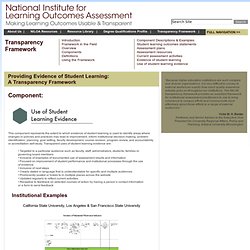
Transparent uses of student learning evidence are: Institutional Examples California State University, Los Angeles & San Francisco State University California State University, Los Angeles as well as San Francisco State University use a reporting template that asks each program and department to respond to a series of questions including: Learning Assessment Conference.
Valencia College invites colleagues responsible for learning assessment, faculty development, student development, curriculum, institutional effectiveness and regional and program-specific accreditation to Orlando February 22-24, 2015 to learn about effectively meeting the learning assessment needs and challenges faced by faculty, staff and administrators in community and technical colleges.
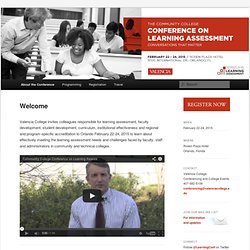
Notice: The 2015 Conference on Learning Assessment website is in the process of being updated. The 2013 Conference materials will remain posted so you can see the Keynote Presentations, Sessions, Agenda, Speakers and more to give you an idea of what you can expect at the 2015 Conference. VALUE Rubrics.